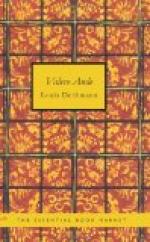VARIETY OF ORGANS.
Why then, you may ask, if such unity exists, why this dissimilarity in the tissues of the respective bodily organs? How is it that a bone in its stonelike hardness is essentially the same as the infinitely tender tissues of the eye? This difference is due to and accounted for by the adaptation of certain portions of the immense accumulation of cells to diverse functions, which has necessitated the variable conformity of the supporting elements. But all of these elements are in the blood, which carries them in the necessary quantities to the different organs to which they belong and where they are utilized to replace used-up matter.
I do not overlook the difficulty of grasping this idea of unity.
The fact, that it is so difficult to realize, has led to the greatest errors in present day medical science.
It seemed at first sight, so obviously necessary to study the different organs as entirely different groups, to work out a careful system of bones, of intestinal organs, of blood-vessels, of nerves, and so on; all of which is of course very valuable, in its place, but only from a descriptive standpoint.
Anatomy shows us what life has produced in the construction of a human form, but it does not indicate the source of life, nor, consequently, the source of health.
It is well to know the different forms of cell accumulations, which are called organs, but if we desire to keep them in good order, we must watch closely what is common to them all; for it is only from this point of view, that we are able to determine the necessary, and possibly, the lacking elements for purposes of healing.
Thus, as one of the greatest achievements of modern science, we come to the one most vital thing, so sorely needed and yet so badly neglected throughout the centuries: The chemical analysis of the human body and its different organs.
A new light has now dawned upon the subject most essential to the inauguration of a new and effective system of healing.
The physiological chemist has at length discovered that the human body, and every organ of that body consists of a certain number of chemical elements, which appear in different parts in different aggregations. These aggregations, however, repeat themselves in the various parts or organs.
It was thus finally discovered that there are twelve different main aggregations of such elements, which groups of equal elements we call tissues.
Through this discovery we have arrived at the great truth that it is not to the purpose, in healing, to turn attention to the various organs, but rather to the various tissues.
The influence which can be exercised on these tissues is exercised through the blood which nourishes all of them alike, and which has the wonderful capacity of carrying to each of them their necessary building and rebuilding, or regenerating materials,—provided, of course, that these are, as they should be, present in the blood.




